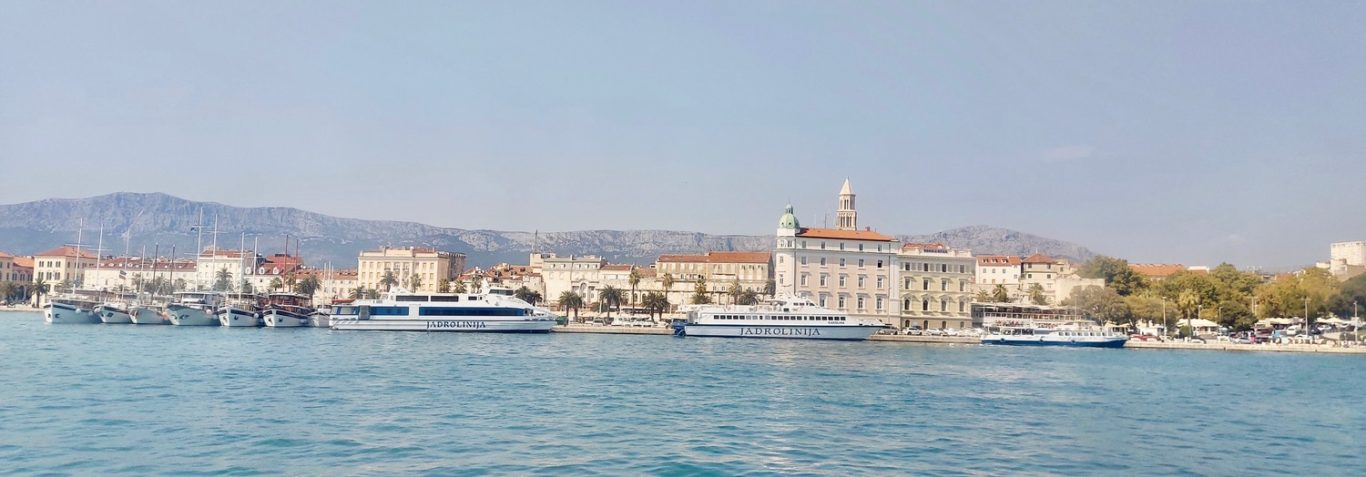A visit to Split is an unforgettable experience and in this post I’ll tell you why.
Main reasons to Visit Split, Croatia
Split is a unique place which – although attracting more tourists every year – still has that authentic vibe you often miss in places that are overrun by mass tourism nowadays.
- In the whole city actually live just over 160 000 inhabitants, but almost 1 million tourist Split these years.
The city offers a unique blend of ancient history, stunning natural beauty, as well as a vibrant atmosphere. A friendly, relaxing & safe destination located on the Dalmatian coast, bordering the Adriatic Sea.

This blog post is written with the help of my daughter Lisa, who shared her own experiences with me touring Croatia.
- IMPORTANT MESSAGE: Throughout this post you’ll find affiliated links & ads provided by the travel platforms like TravelPayOuts & GetYourGuide. Links & ads that may help you plan & fill in your next trip to Croatia.
- If you click on them & buy a ticket for a museum or a tour a small commission of your purchase will go to me (Paid by the provider, without any extra cost to you!).
- If you first want to learn a little bit more about me, the blog writer, please click on: Better call me Art.

Short History of Split, Croatia
I’d like to start my post by giving you an idea of Split’s history. The main reason being the fact that the city’s greatest attractions are hidden in its fascinating past. Especially its Roman past.
Greek & Roman roots
The biggest expression of Split’s Roman history is the beautiful palace built by order of the Roman emperor Diocletian (3th/4th century AD). Split’s biggest marvel today, attracting hundreds upon hundreds daily visitors.
- Although Split’s old center is clearly Roman in outlook, the city’s roots stretch back to the third or second century BC when it was founded by Greeks as a colony called Aspálathos or Spálathos.
Christian make-over
Soon after Diocletian died, one of his immediate successors – Constantine the Great – converted to Christianity (in 312 AD).
A revolutionary step which – in the long run – would have enormous consequences for the whole Roman Empire. Including Split, where several Roman structures would be converted into Catholic places of worship. Like the Temple of Jupiter & Diocletian’s Mausoleum (see below).
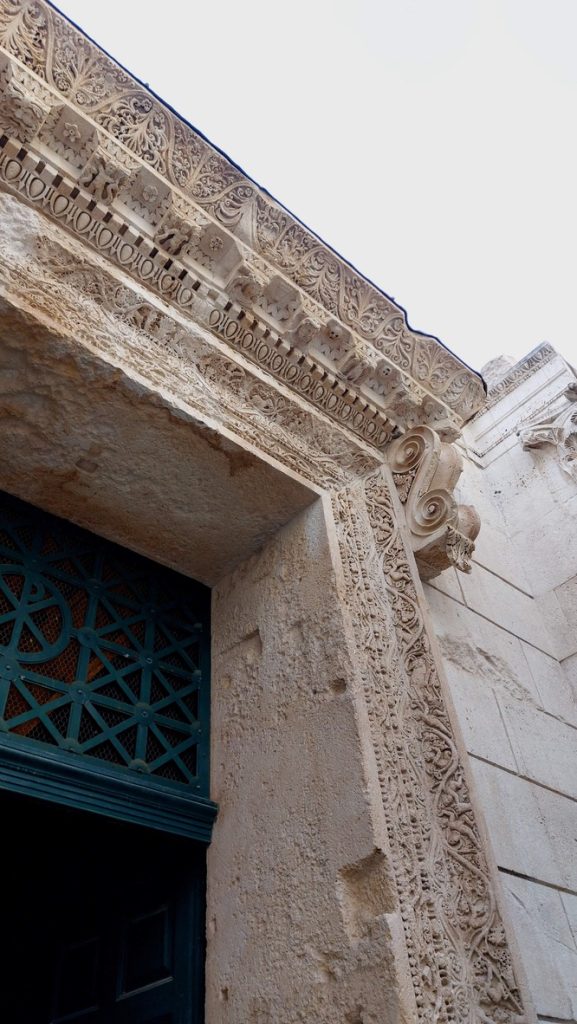
- After the Fall of Rome, Split – or better, all of Croatie – would not only be a high valued price for wandering tribes in the area, but also for the powers to be. Besides belonging to the Byzantine Empire for some centuries, we can think of the Venetians. And later on also the Habsburgs, rulers of the Austrian Empire.
Modern history
After the First World War – in 1918 – Croatia was incorporated into a bigger state, namely Yugoslavia. A country which housed several Balkan countries. Including modern-day republics like Slovenia, Bosnia-Herzegovina, Serbia & others.
All these states & peoples shared a common Slavic heritage, but also had distinct historical & cultural identities. Differences which often led to tensions & conflicts within the new borders. Certainly during the Second World War, when Yugoslavia was first occupied by Italy & then by Germany.
Although the tumultuous artificial state of Yugoslavia would survive the war and was held together afterward by a strong “national” charismatic leader, Marshal Tito – an internal conflict was always lurking.
- Josip Broz Tito was born in 1892 to a Croat father & a Slovene mother, in what at the time was still Austria-Hungary.
After Tito’s death in 1980 things went down rather fast. Leading to several ugly internal wars between the Slav peoples in the early 1990s & in the end six states instead of one. One of them being the Republic of Croatia.
- During the Croatian War of Independence (1991-1995) Split was not directly involved in the most intense battles. Although the city was significantly impacted by the conflict, it escaped the level of destruction other Croatian cities experienced. Happily the Diocletian’s Palace survived the war intact.
Visit Split – Historical Highlights in the city center
Diocletian’s Palace
The Palace of Diocletian – Roman Emperor between 284 and 305 AD – forms the heart of Split’s old city center. A UNESCO World Heritage Site which offers a fascinating glimpse into the past.

Instead of consisting of one solid structure, the palace of Diocletian is actually built as a mini village. Or a neighbourhood, if you like. Complete with protective walls & watch towers, but also streets, squares, gardens and several ceremonial buildings. Monuments, which nowadays are Split’s main attractions.
- Within the palace the southern part – seaside – actually housed the emperor’s private quarters. Completed with several inner courtyards & gardens.

Nowadays many inner structures are converted into shops, bars, restaurants, hotels & apartments. While you’ll also find a lively fresh produce market within its walls. Mainly for the thousands of people who still live within the city walls.
Monuments within Diocletian’s Palace
To name a few of the main historical buildings within the palace:
The Peristyle
The main square within the palace is called the Peristyle or Peristil. It’s surrounded by awe-inspiring historic structures. Roman to the core. A popular spot where nowadays past & present come together.
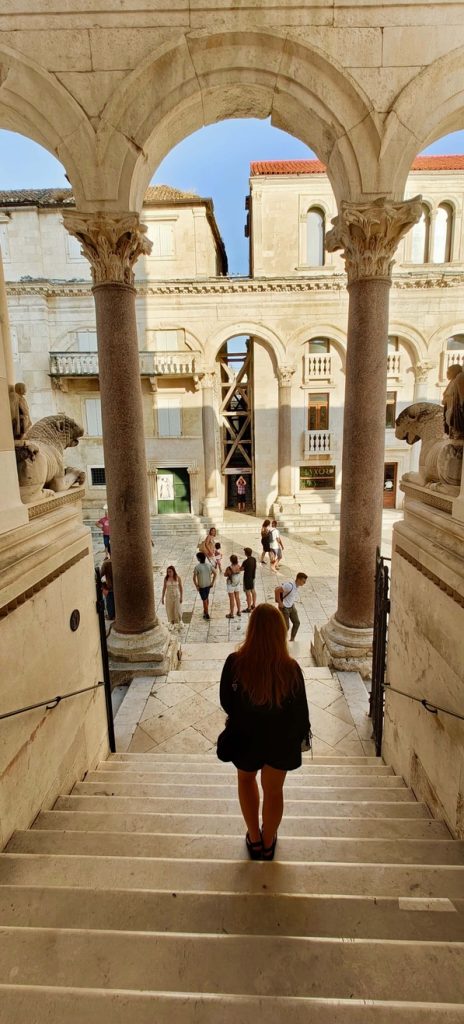
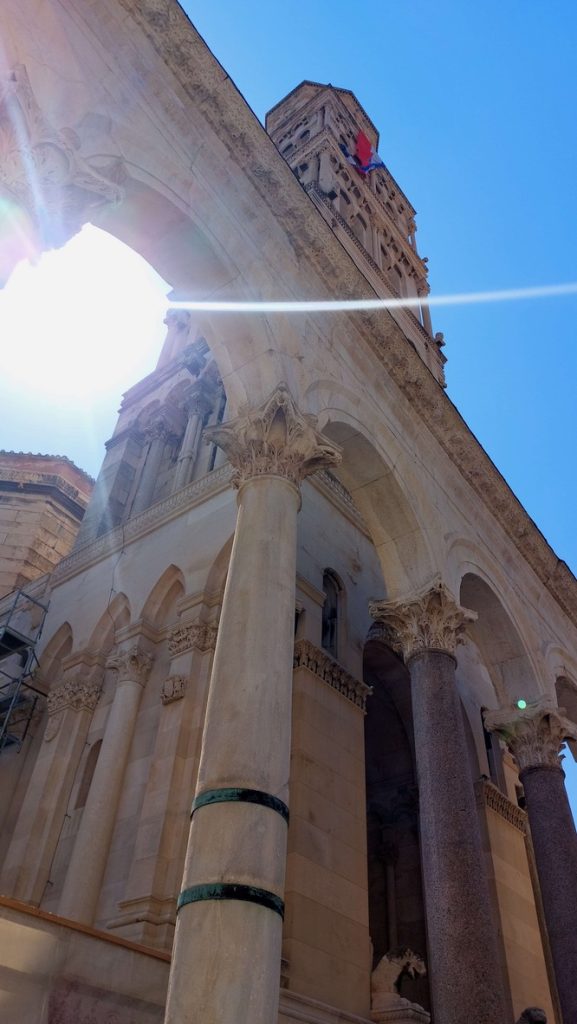
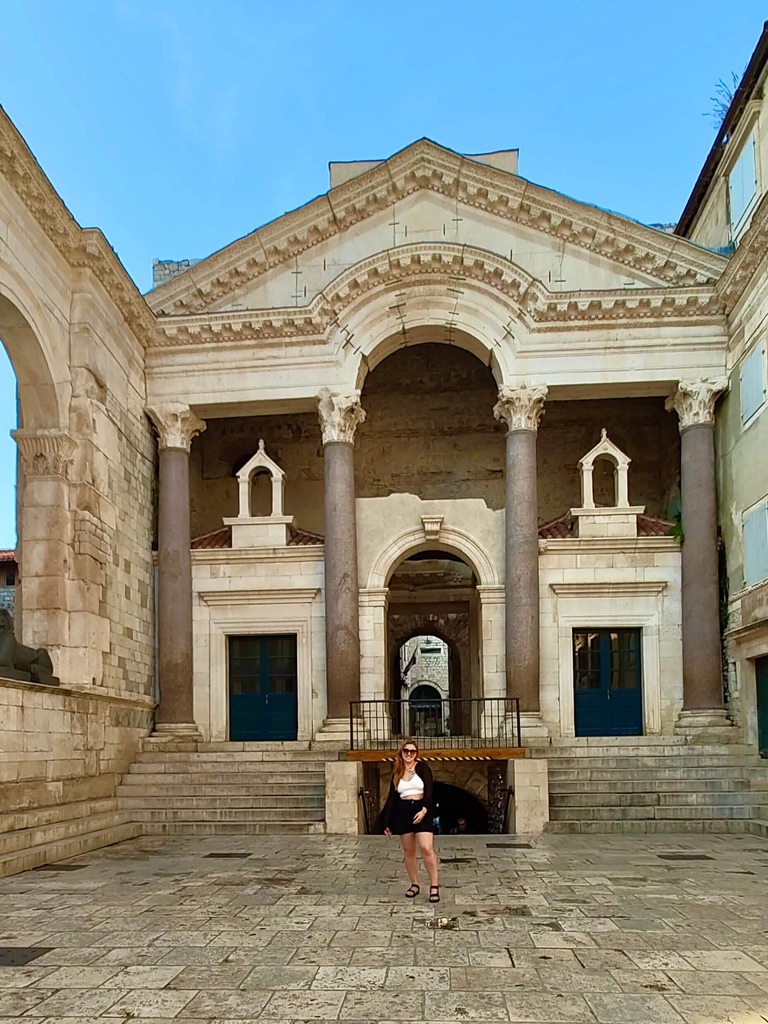
Temple of Jupiter
Very near the Peristyle square, you’ll find the Temple of Jupiter. An impressive Roman temple which soon after the fall of Rome – in the 6th century – was converted to a Christian place of worship.
- In front of the entrance you’ll find one of the twelve sphinxes which Emperor Diocletian brought from Egypt (In this case without a head, as Christians thought the sphinx was a pagan symbol.)
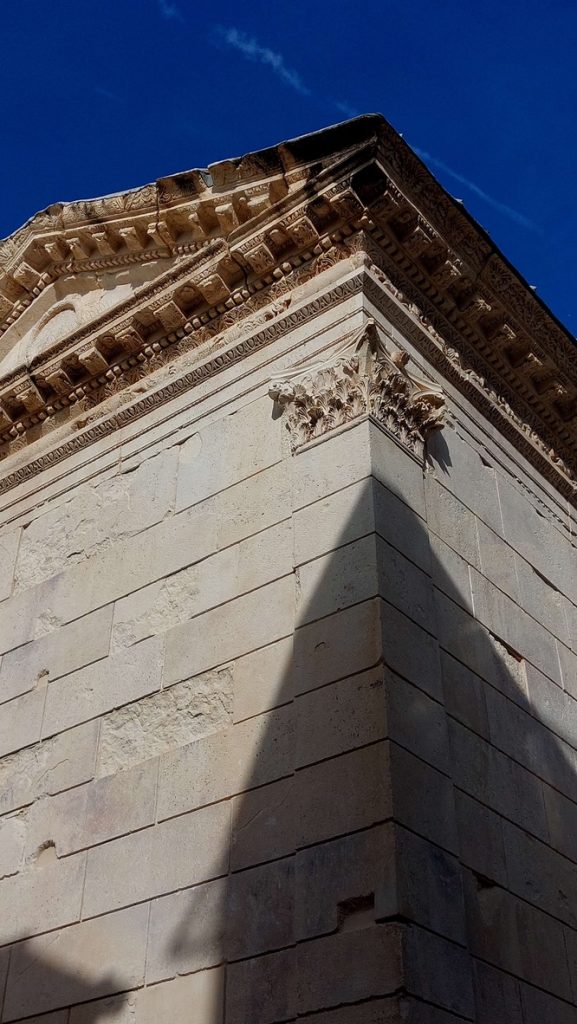
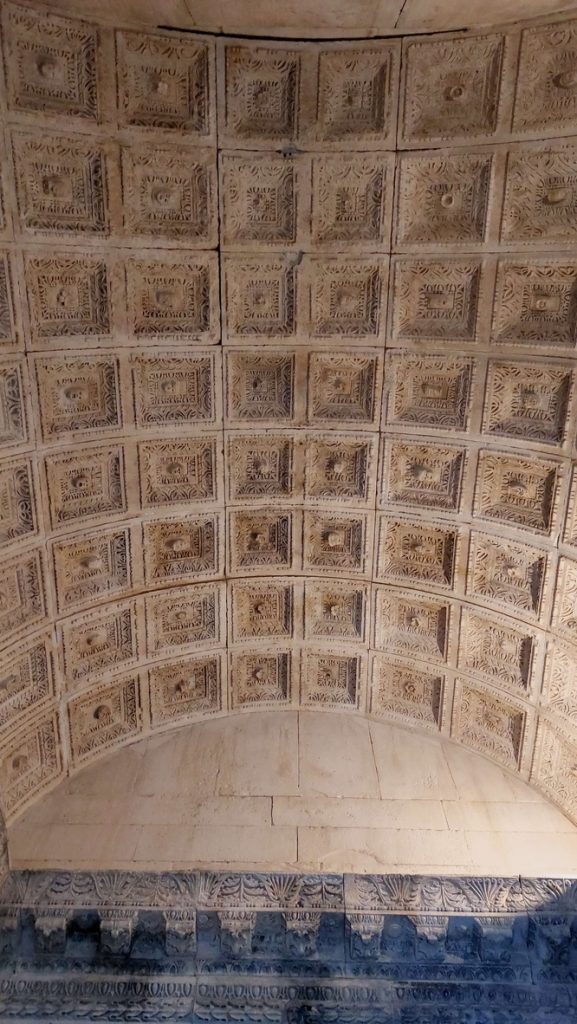

Impressions of our visit to the Temple of Jupiter in Split – still Roman inside & out.
Diocletian’s Mausoleum/Saint Domnius Cathedral & Bell Tower
Located on the main square you’ll find the Cathedral of Saint Domnius, and its impressive bell tower. Both are worth a visit.
- The cathedral is a blend of Roman, Byzantine & Gothic building styles.
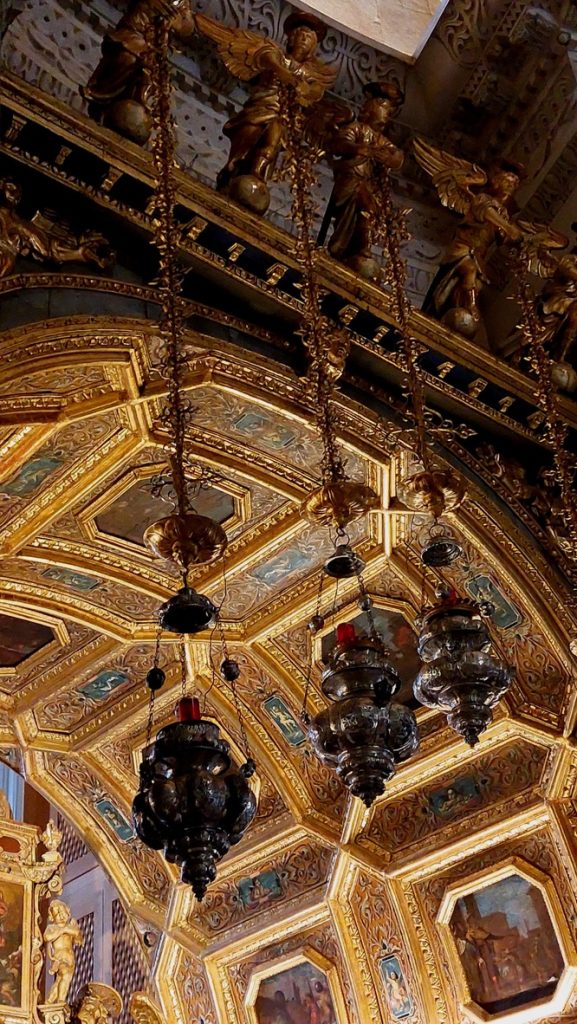
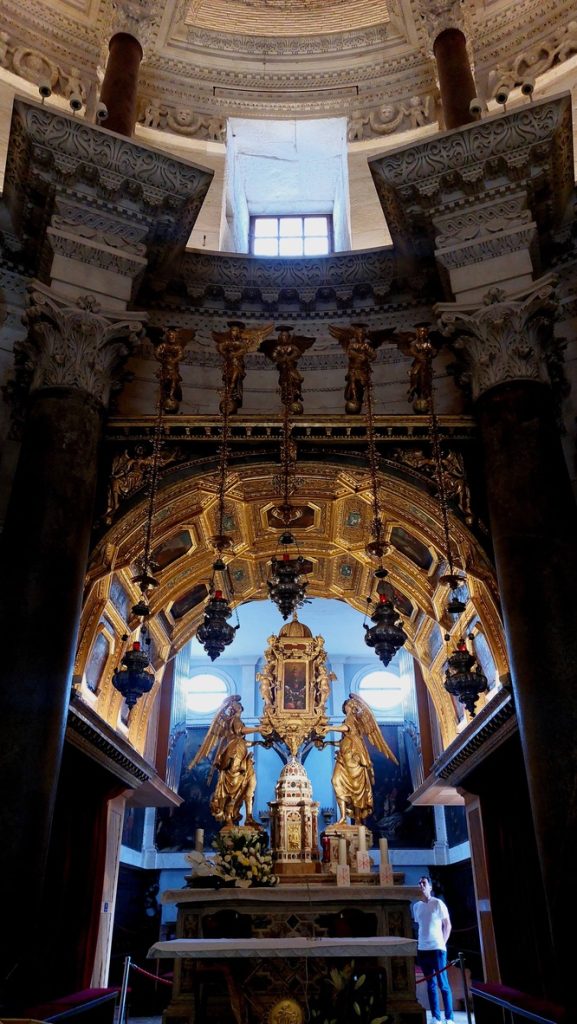
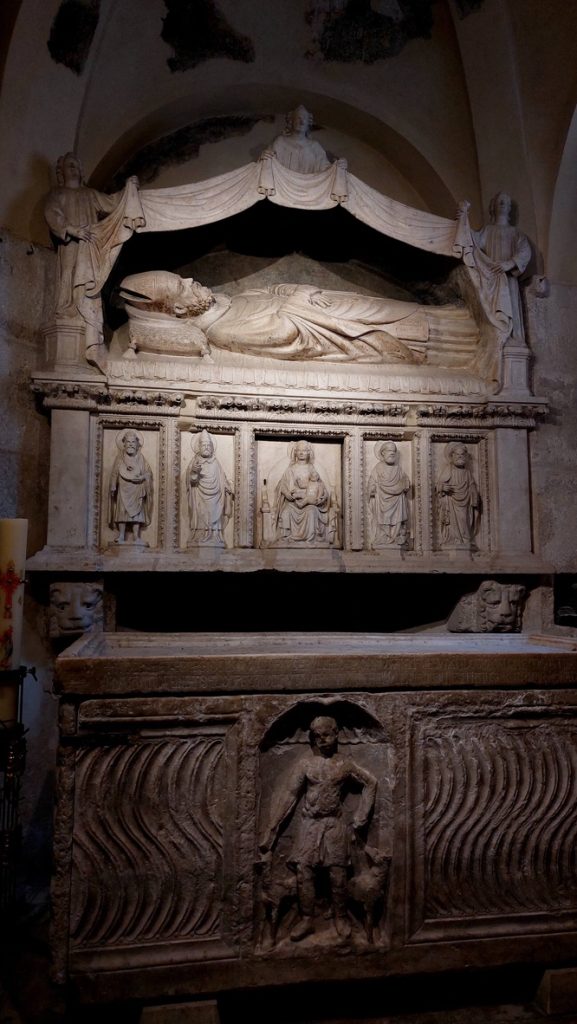
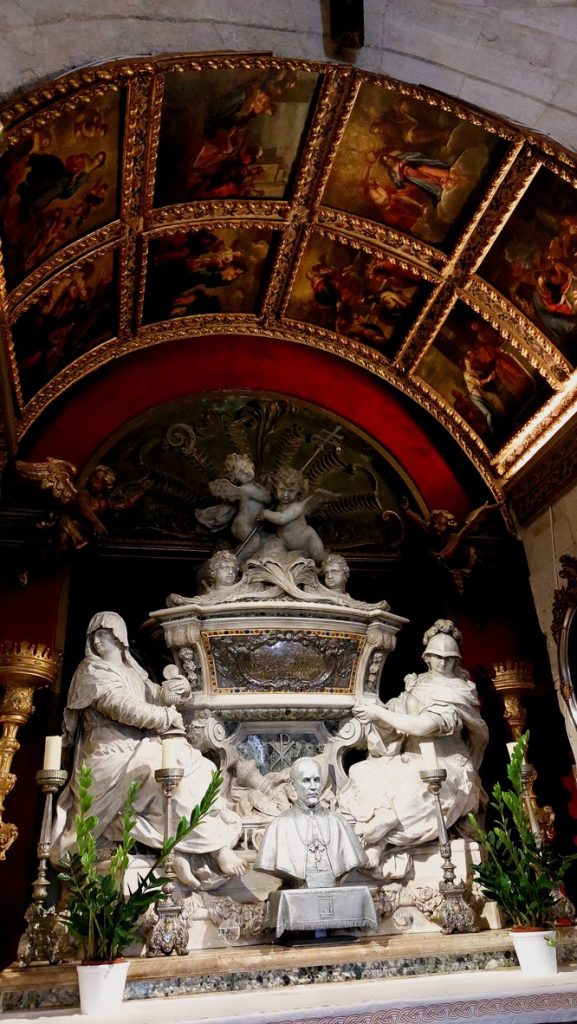
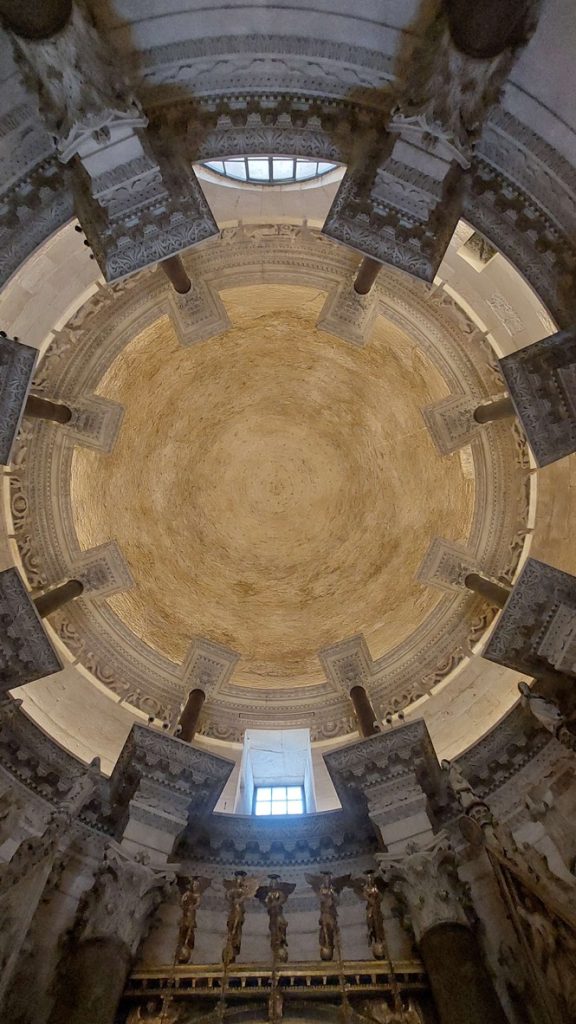
Impressions of the interior of the Saint Domnius Cathedral in Split. Resting place of many a Saint.
Although hardly visible today, this catedral was formerly Diocletian’s Mausoleum. It was converted into a catholic church in the 7th century, while the bell tower was added at the beginning of the 12th century.
The 57 meter high bell tower is beautiful as well, and offers – after climbing up the 173 steps – great panoramic views of Split & its surroundings.
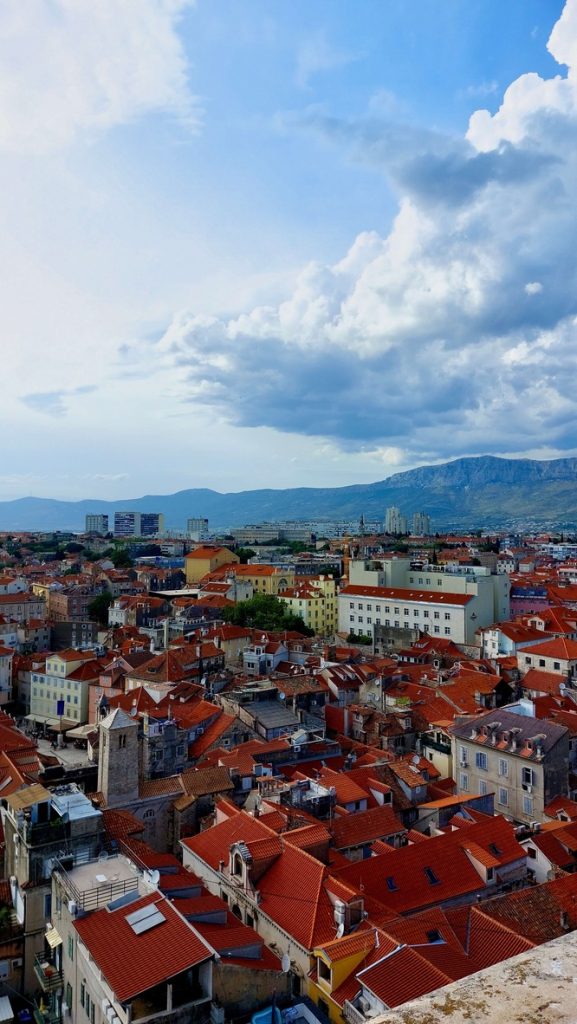
Saint Lucia’s Crypt
Located at the Roman foundations of the Cathedral of Saint Domnius, you can visit the crypt of Saint Lucia of Syracuse. A Christian martyr who died by the Roman sword in the time when Diocletian was Emperor.
The crypt is believed to be Lucia’s final resting place. Besides a chapel dedicated to her, you’ll find a statue of St. Lucia & a holy water spring here. (Mainly sought out by people with eye-diseases, like the blind, as St. Lucia is considered their protector).
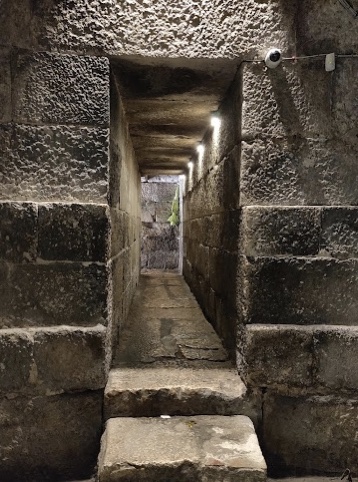
TravelTip: Although many visitors are disappointed after a visit to this somewhat sober place of worship, I think the crypt is worth a quick visit. It’s often included in a walking tour of the city center.
Statue of Gregory of Nin
Formerly located just outside of Diocletian’s Palace – in front of the Golden Gate – but worth a mention here, stands the impressive bronze statue of Gregory of Nin.
- Gregoro of Nin was a Croatian bishop who lived in tenth century. He played an important role in the Christianization of his country.
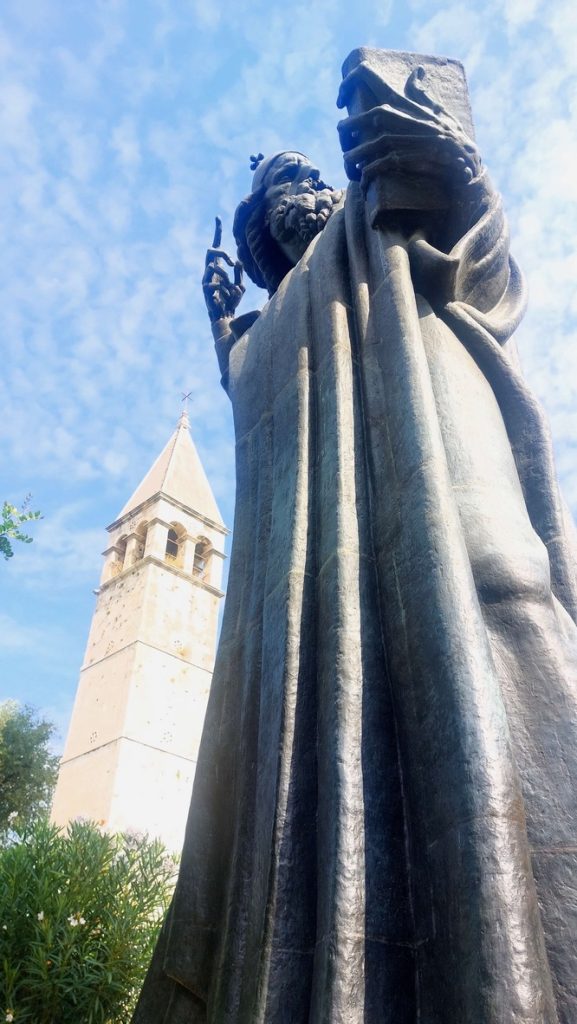
The statue is a popular tourist attraction. Mainly because the tale goes that rubbing its big toe brings good luck.
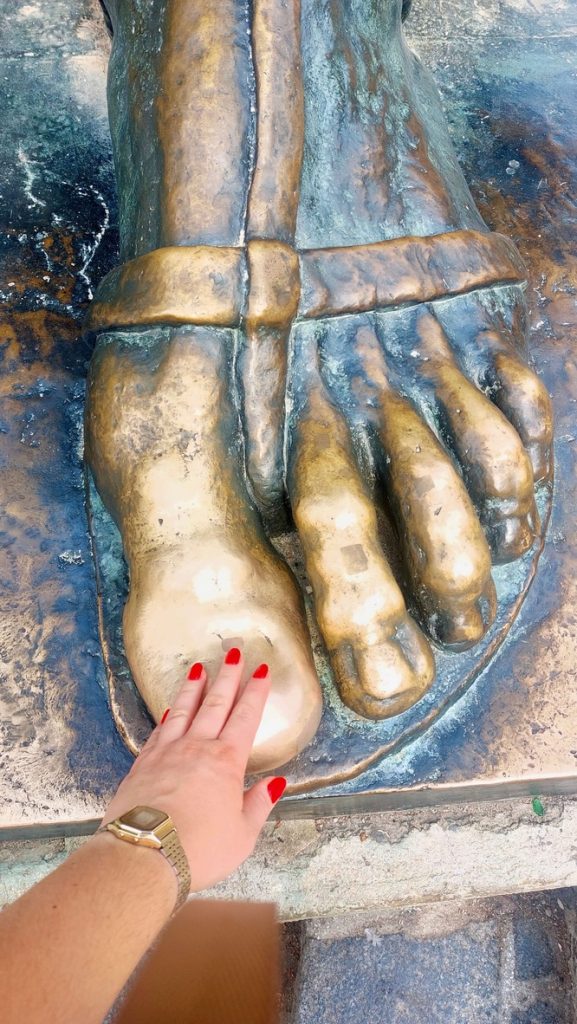
Museums within Diocletian’s Palace
The Archaeological Museum, Split
The Archaeological Museum is housed in several buildings & courtyards of Diocletian’s Palace. Well worth a visit. Providing a background to the region’s oldest history.

To learn more about the Museum, go to: Archaeological Museum of Split
The Split City Museum
As the name indicates, the Split City Museum tells the story of the city’s development through the ages. It’s housed in a medieval building within the palace complex.
To learn more, go to: Split City Museum
TravelTip: Although their website says it provides information in English, I couldn’t find any. However, in the museum itself you’ll find explanations in English, besides Croatian.
How to visit Diocletian’s Palace, Split
You can easily explore the old city center of Split on your own. However, when you really want to know the history behind it all, I’d recommend you to take a professional guided tour.
GetYourGuide offers several guided walking tours, but the most popular one is:
Click on the following link to learn more: The Old Town & Diocletian Palace Walking Tour
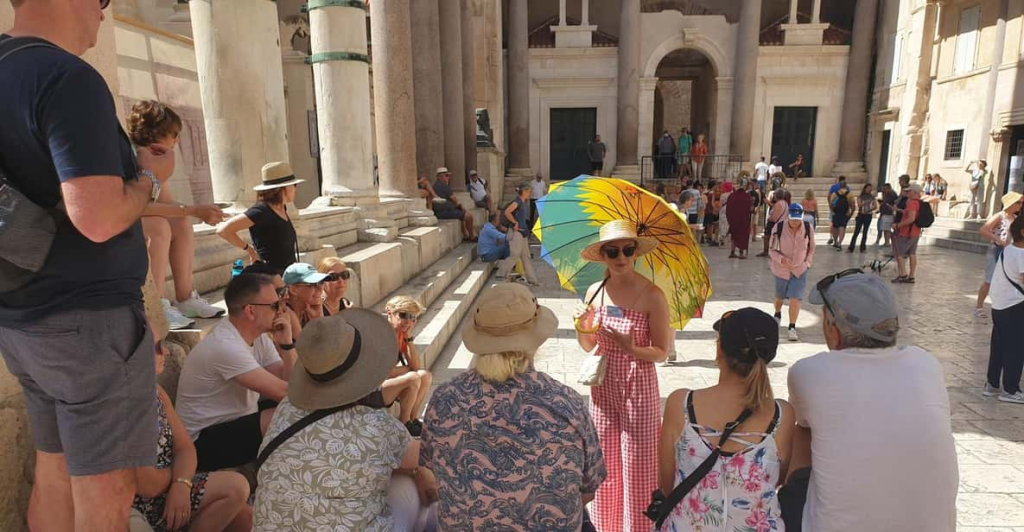
Games of Thrones in Split
As Split was one of the many filming locations for the popular television series Games of Thrones, it will be no surprise there are special tours for their many fans.
For those who are interested, just click on: Split Games of Thrones Tour, the City of Dragons
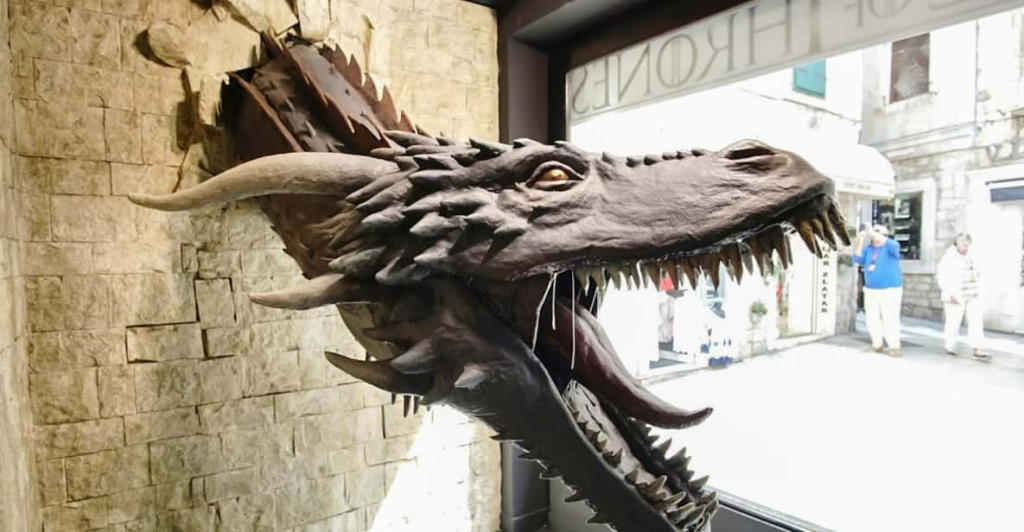
TravelTip: There’s also a Games of Thrones Museum in Split, but many visitors say it’s very small & overpriced. (The above-mentioned GetYourGuide Tour provides you with a 20% discount on the entrance price, but still…). Only for the real Die-hard fans, I’d say.
Visit Split – Strolling along
The Old Town
We strolled around the old town several times. Early morning, as well as in the evening/at night, when most tourists had left the inner city. Can’t give you a better tip really. Enjoy!
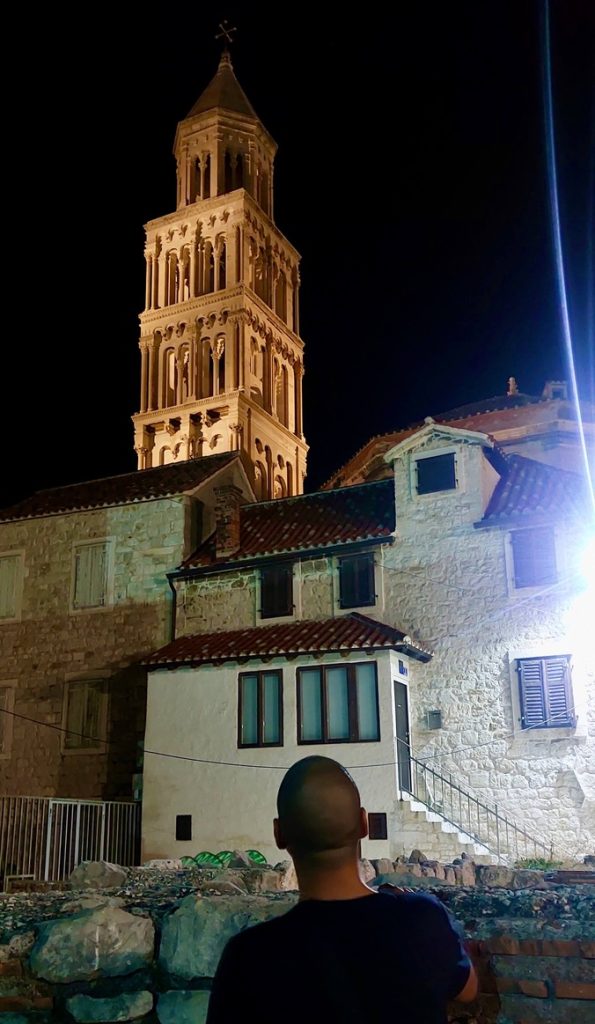
Riva Promenade
Besides losing yourself in the inner city, the waterfront promenade is a perfect spot to relax. A hub of activity, lined with cafes, restaurants & shops. Offering a lively atmosphere day & night.
TravelTip: Although Croatia is still cheaper than other European destinations, prices have gone up considerably the last couple of years. Mainly because of its growing popularity. Besides that, when you visit Split you’ll soon notice that prices on the Riva Promenade are considerably higher than in other parts of the city. Just to let you know.
TravelTip: And – talking about money – take some cash with you (euros in this case). Always handy, but also because most businesses prefer cash & sometimes you can even get a better price when buying local products and/or souvenirs.
Visit Split – Culinary tips & tours
As you would expect for Split’s location, the local cuisine offers a lot of fresh seafood. That is, besides grilled meats & well-known famous international dishes, like authentic Italian pizzas & pastas.
Here are some of Split’s gastronomic specialities (names to remember):
- Black risotto: This unique dish features squid ink & rice, resulting in a dark, but flavourful risotto.
- Pašticada: A traditional Croatian stew made with beef, dried plums & a rich, savory sauce.
- Peka: Not a dish, but a method of cooking meat or fish under a bell-shaped lid, often with vegetables & potatoes.
- Seafood dishes: As mentioned, freshly caught fish, grilled or baked, is at the heart of Split’s cuisine.
Don’t forget to try certain local products, like: wine, olives, olive oil, anchovies, honey, cheese, yogurt, prosciutto, herbs & spices + Dalmatian cookies.
Eating/drinking out Tips:
The best restaurant we visited by far was the Pigeria Gudin (not a Croatian Pizzeria as we initially thought). Best food, friendly service & a inspiring location. Highly recommended. Only warning: don’t lose yourself in their enormous wine list!!
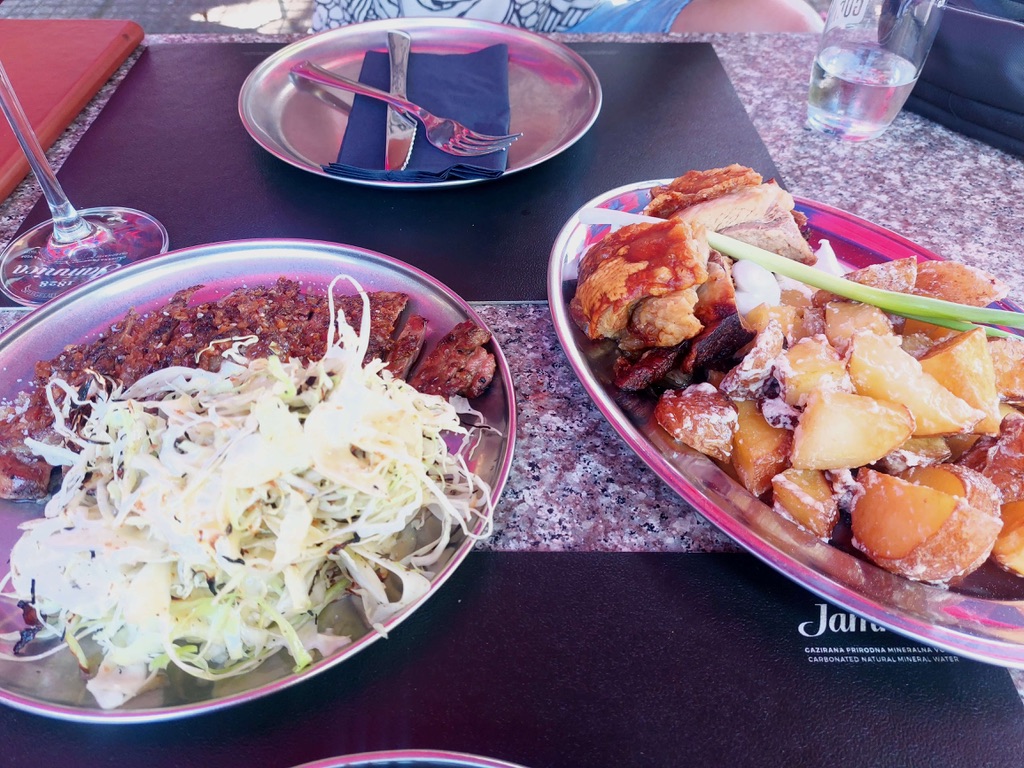
Another restaurant we enjoyed was the Restaurant Luxor. The food was good (not great, like at the Pigeria Gudin), but the ambience & location is just amazing.
- At the Luxor you can also sit outside & sip a drink, while watching the world go by. People coming & going to visit the most famous monument of Split, Diocletian’s Palace. While at night, they offered live performances & people were dancing on the square.
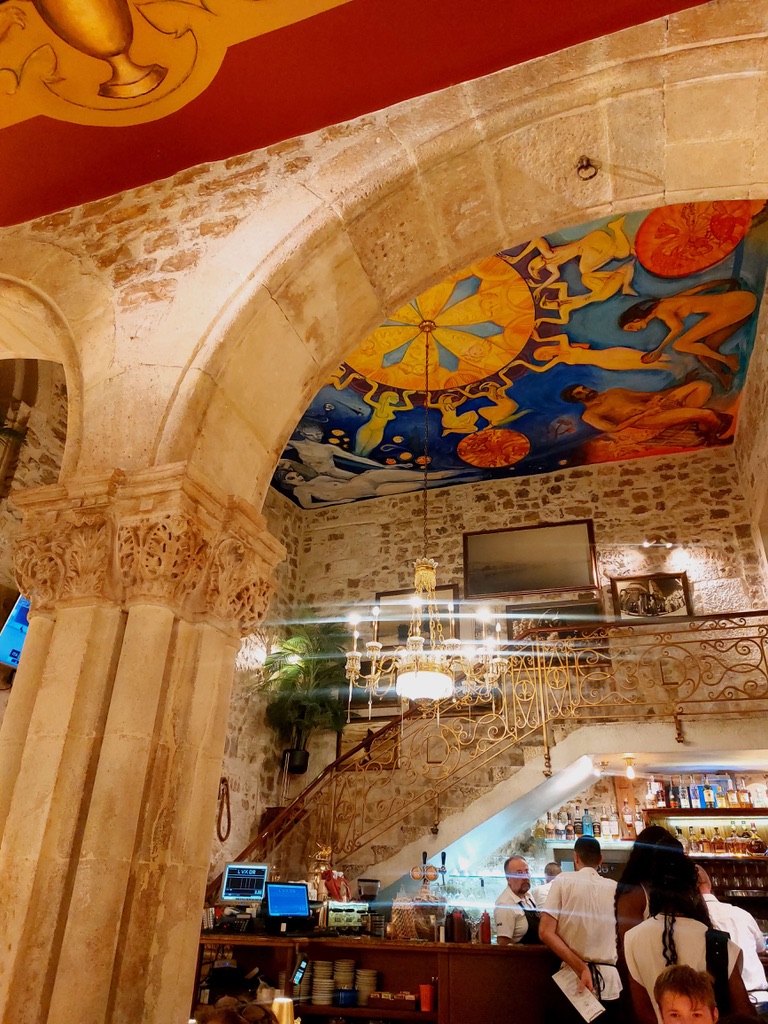
For a nice bar, with a relaxing ambience & friendly, sympathetic bartender from Argentina, try the Marvlvs Library Jazz Bar. (An extra here were the honest prices. Way more affordable as bars & terraces on the Riva Promenade).
Markets
There are several markets in the inner city, with fresh produce. Not only fruit & vegetables at the Green Market, but also sea food at the Fish Market.
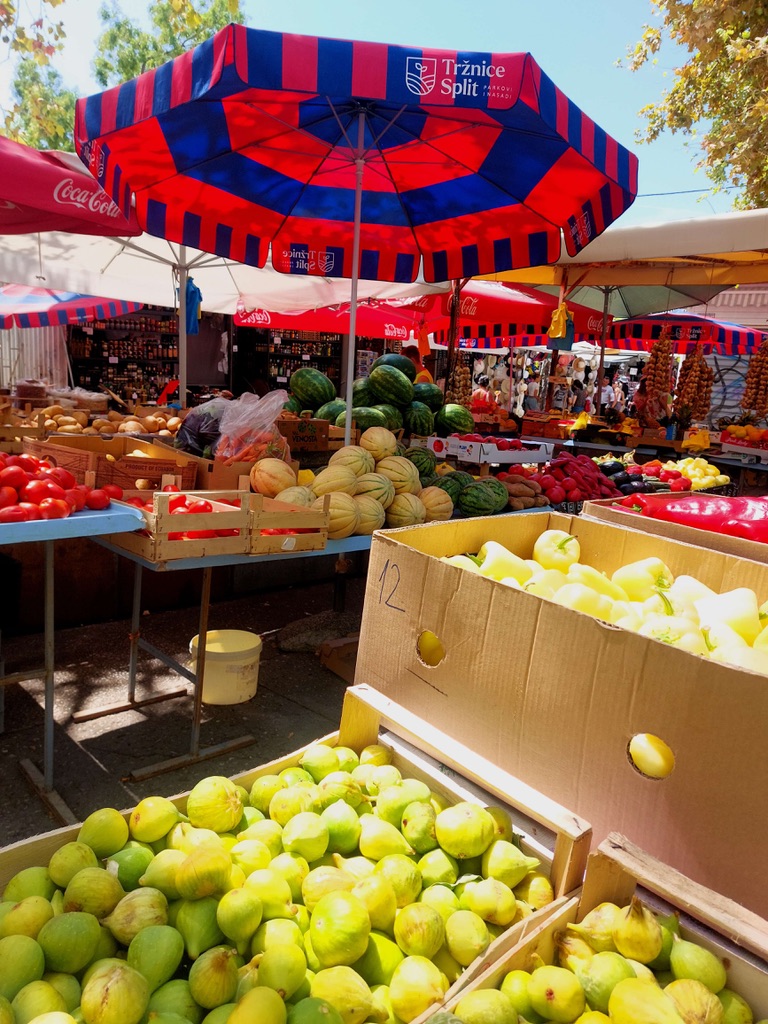
TravelTip: At the fish market we bought fresh anchovies, which we used to complete pizzas & sandwiches we bought elsewhere. Or took with us on day-trips.
TravelTip: Getting Around in Split
It probably won’t come as a big surprise when I tell you to buy some good walking shoes to explore Split’s old city center. There’s no other way & it’s the perfect way. Walking & strolling around to see, experience & feel it all.
If you don’t have a (rental) car at your disposal, there are several other ways to get to the attractions near Split. For example, if you want to visit the Marjan Hill – just outside of town – and don’t want to walk up, you can either use public transport (bus) or take a taxi. Besides several other fun alternatives (see below).
For day trips outside of town, I’d like to recommend you to take a professional guided tour, including transport.
Visit Split: Hotel Tip
As in other popular desitinations there are hundreds of hotels in Split to choose from. Your choice logically depending on your personal wishes & your budget.
However, I’d highly recommend you to find a hotel in the central part of the city. As this gives you the chance to get to know the city the best. Strolling around at an early hour, if you like. Or late at night – always a special moment.
That said, I personally like to recommend you the Hotel Park. A modern mid-range hotel with a friendly staff, clean, spacious rooms & a nice pool. Located at the waterfront & at walking distance of the old city center.
- It took us 15 minutes to get to the city center, 20 minutes along the waterfront.
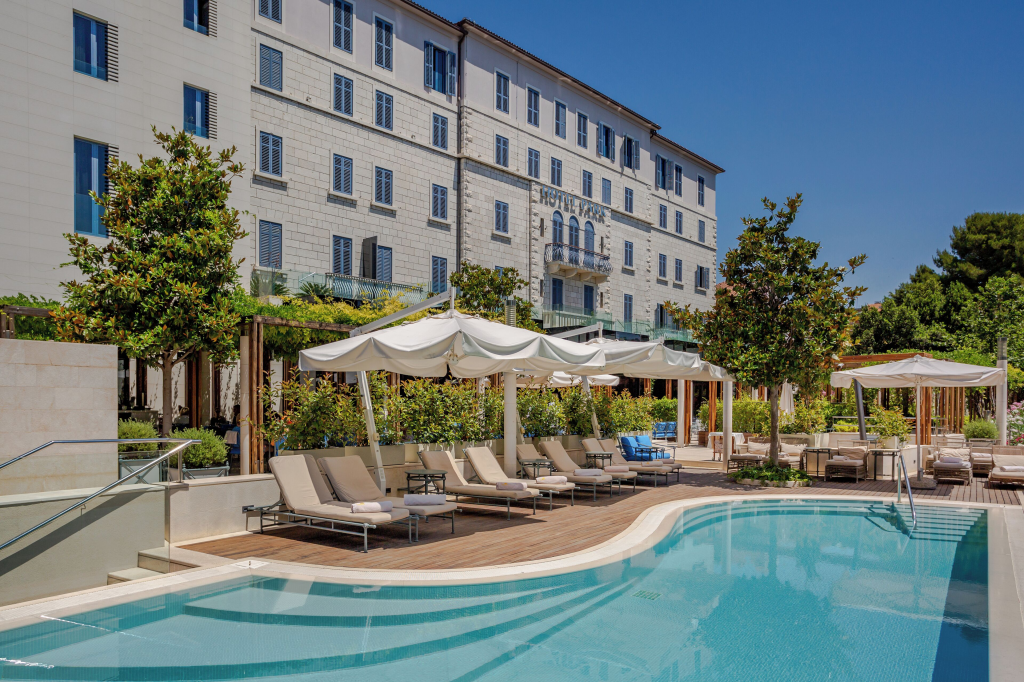
To learn more about this hotel, go to: Hotel Park, Split
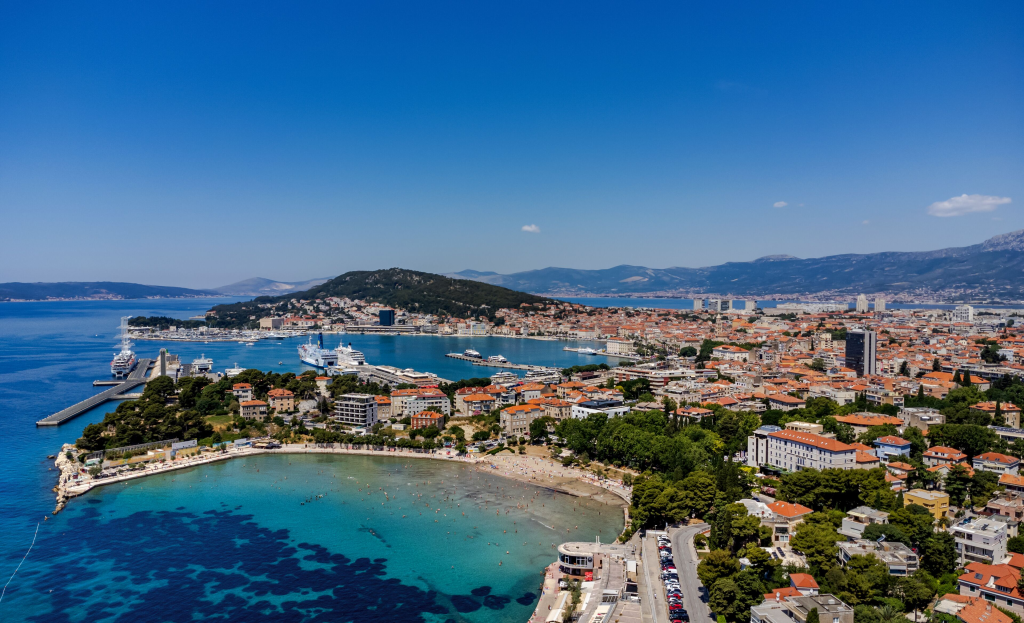
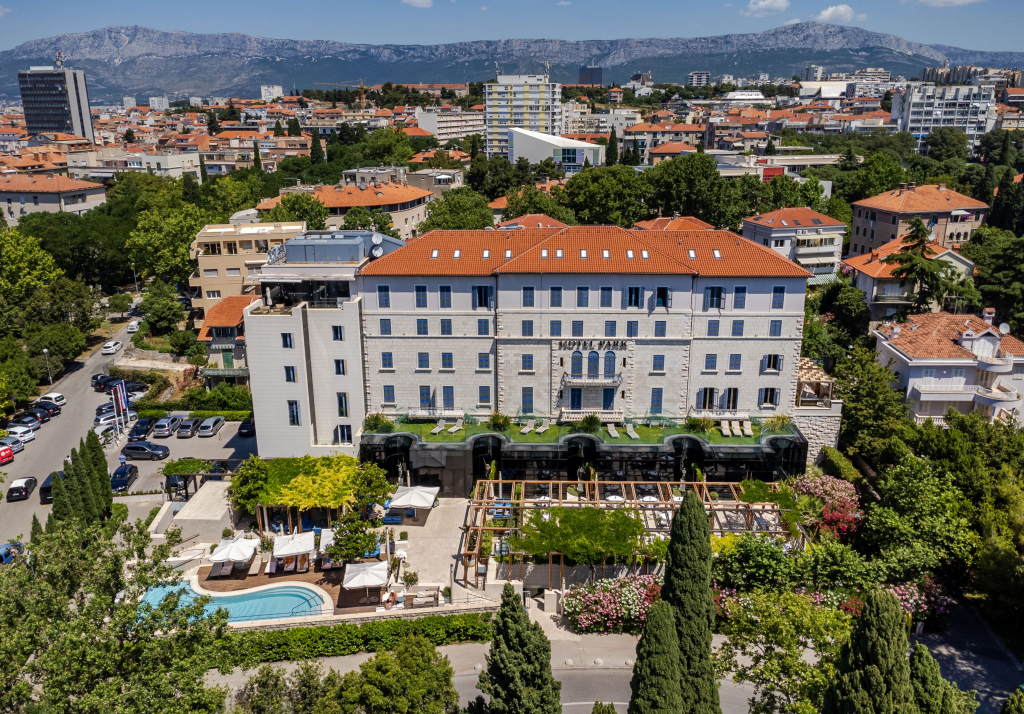

Visit Split – Stunning surroundings
The Marjan Hill
Let’s start with the most obvious natural feature near Split. Easily visible from the city center, the Marjan Hill.
High above the city of Split you’ll find this green oasis. Offering spectacular panoramic views of the city, as well as the Adriatic Sea. Besides being a perfect escape from the urban hustle, it’s also a nice place to hike in the area.
However, if you don’t feel like walking up you can arrange a taxi. Or else, include a visit to the Marjan Hill on a GetYourGuide Tour.
Click on your preferred means of transport up the Hill, to learn more:

Nearby Beaches
No surprise here. Near Split you’ll find some nice beaches. From the popular, lively Bacvice Beach to the more secluded Kasjuni Beach. Both blessed with crystal clear water. Ideal for a refreshing dive in the Adriatic (during the warmer months, May until October).
TravelTip: As parts of the Dalmatian coast are pretty rough still, I highly recommend you to buy some water shoes. Mainly protecting your feet against stones, sharp rock & sea urchins.
Activities along the Dalmatian Coast
It won’t either be a surprise when I tell you that Split is the perfect base for adventurous & fun activities along the Dalmatian coast. More so, because there are some interesting islands nearby – like Brač, Hvar, Šolta & Korčula (birthplace of Marco Polo) – with their own vibe & the best beaches around.
In the ad below I’ve grouped some of the most popular Islands tours, starting in & returning to Split the same day.
Just have your pick, to learn more:
Besides boat tours on the Adriatic Sea, there are also some fun activities for you in the area around Split, like:
Day Trips around Split
Besides the tours already mentioned, there are some Day Trips from Split which are worth considering.
Split’s central location makes it an ideal base for exploring other Croatian destinations, such as:
Day Trip to Dubrovnik
A Visit to Dubrovnik from Split is packed in a long day trip – 12 hours total – but certainly worth it. An absolutely unforgettable experience.

Dubrovnik is – like Split – a city with a long history (UNESCO World Heritage Site since 1979). It’s located in southern Croatia, fronting the Adriatic Sea.
Dubrovnik is considerably smaller than Split, but as interesting because of its beautiful historical center. A part of the city full of fascinating historical buildings, but also many shops & restaurants.
- The bus takes around 3 hours each way, but leads you principally along the scenic Dalmatian coast.
To learn more about this tour, go to: Visit to Dubrovnik, from Split
Day Trip to the Plitvice Lake Area
A visit to the north of Split this time. A visit to the mesmerizingly beautiful Plitvice Lake Area (16 interconnected lakes). A real natural gem.
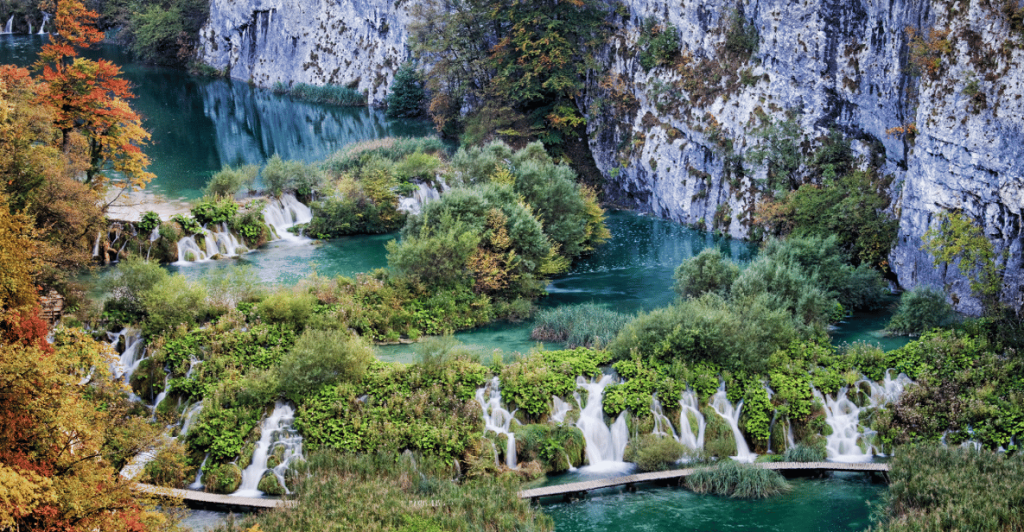
- The drive up to Plitvice from Split is around 2.5 hours, but leads through an inspiring mountainous area.
To learn more, go to: Visit to the Plitvice Lake Area, from Split (this specific tour includes entrance tickets, which aren’t really cheap)
Day Trip to te Krka National Park
Quite a bit closer to Split you’ll find another beautiful & healthy green area worth your visit: The Krka National Park. As the Plitvice Lake Area, a park blessed with many lakes & waterfalls. Natural wonders you will visit on foot, but also on a boat tour.

- The bus ride will take a little over 1 hour along the Dalmatian coast.
TravelTip: The main difference between a tour to Plitvice & the Krka National Park – besides the distance – is the fact that the last area is somewhat more rugged & adventurous. In addition, the day trip to the National Park includes a visit to the old seaside village of Primošten & its beach (for a swim if you like).
To learn more: Visit the Krka National Park (in this case the price doesn’t include the entrance ticket to the park)
Day Trip to the Mostar & Kravica Waterfalls
Last, but not least, a border crossing. Enjoying a day trip to the charming town of Mostar in Bosnia and Herzegovina, including a visit to the stunning Kravica Waterfalls.


- Including the border crossing, the bus drive between Split and Mostar will take about 2.5 hours. On the way back you’ll visit the Waterfalls.
To learn more, go to: Day trip to Mostar & Kravica Waterfall, from Split
TravelTips: Personal Safety
We felt safe while visiting & staying in the city center of Split. From early morning until late at night, after leaving a restaurant or a bar.
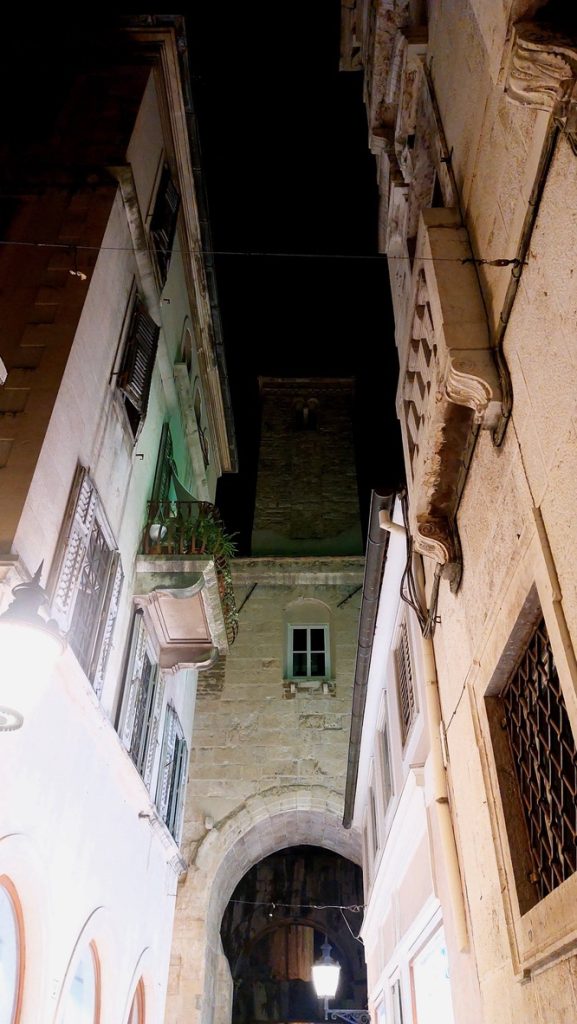
TravelTip: However, as with any tourist destination, it’s important to exercise common sense & take certain precautions. Just always be aware of your surroundings & don’t display personal valuables openly.
In conclusion: A visit to Split
Split is a surprisingly beautiful, safe & friendly place to visit. A place that every year gets more & more visitors, but stays authentic so far & hopefully forever.
When there you can’t miss the Diocletian Palace, nor a visit to the Marjan Hill or one or several of Islands nearby. Besides that, from Split you can participate in all kinds of fun & interesting outdoor activities. As well as unforgettable day trips.
In a few words, I highly recommend a visit to Split. At least stay there for 4 nights before travelling any further. As we did.
Continuing on to the small town of Šibenik, an hour’s drive from Split. Followed by a visit to Zadar, another hour further on.
- TravelTip If you like to travel by bus – fast, economic & relaxed – you can use the following link to find the best bus connection for you within Croatia or Europe: Busbud Europe
Photo Impressions of our visit to Split
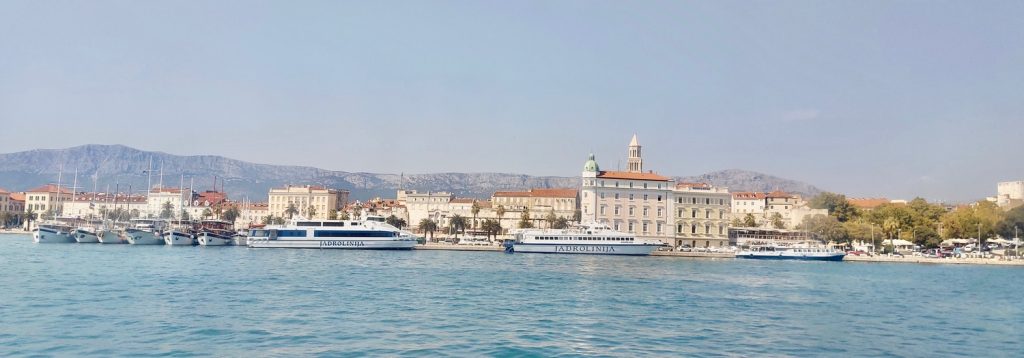

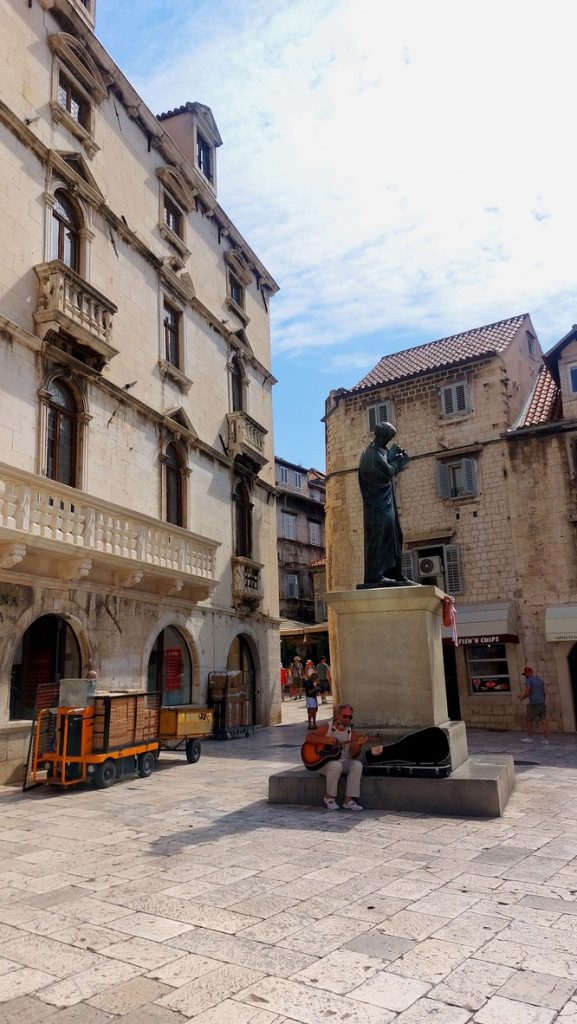
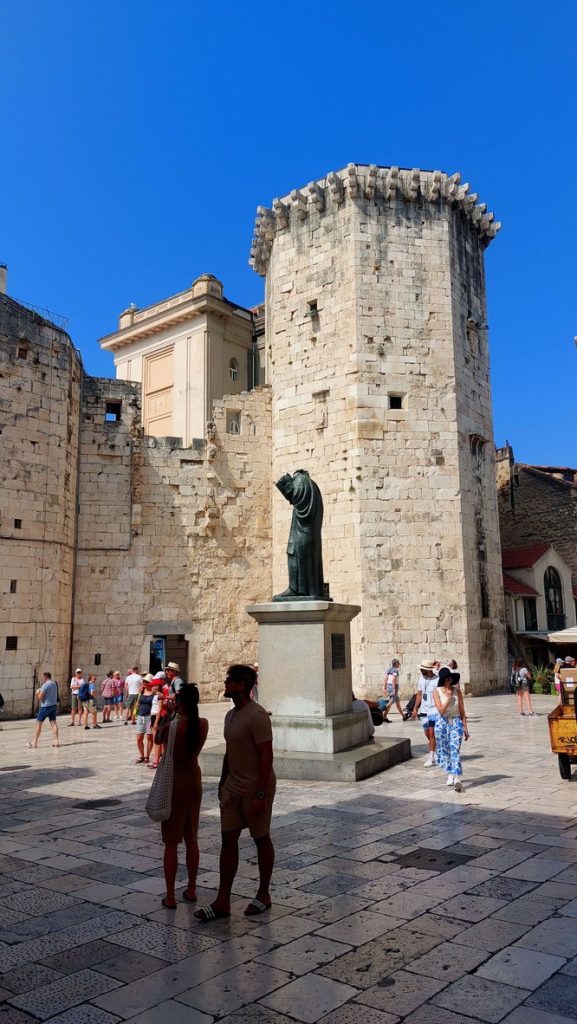
Visit to the Brothers Radić or Fruit Square in Split, with the statue of the Croatian poet Marko Marulic.
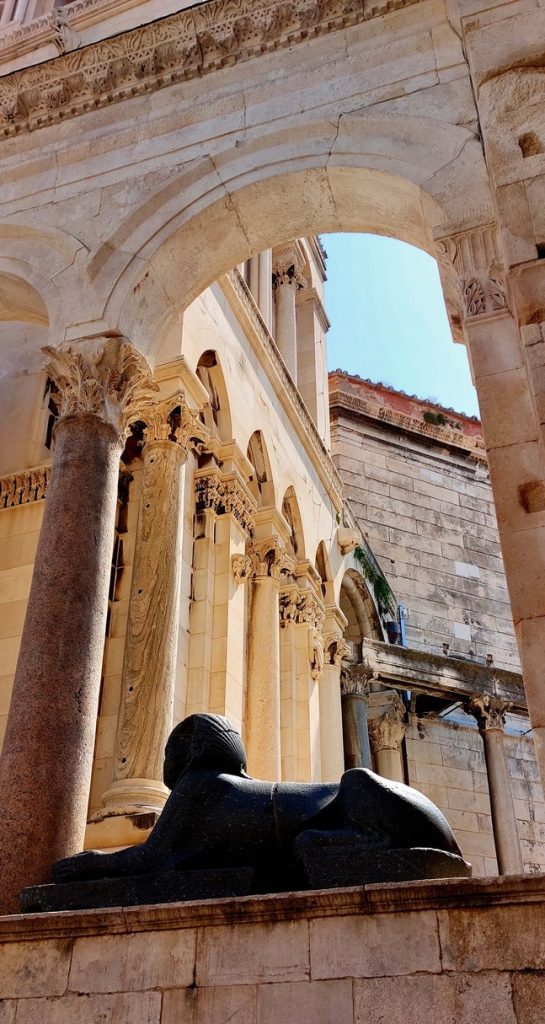
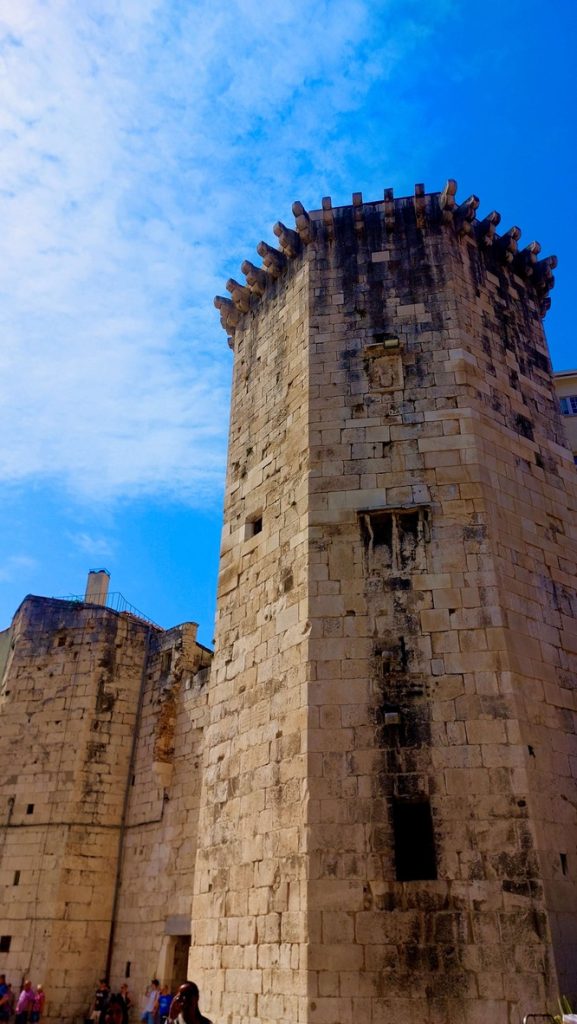
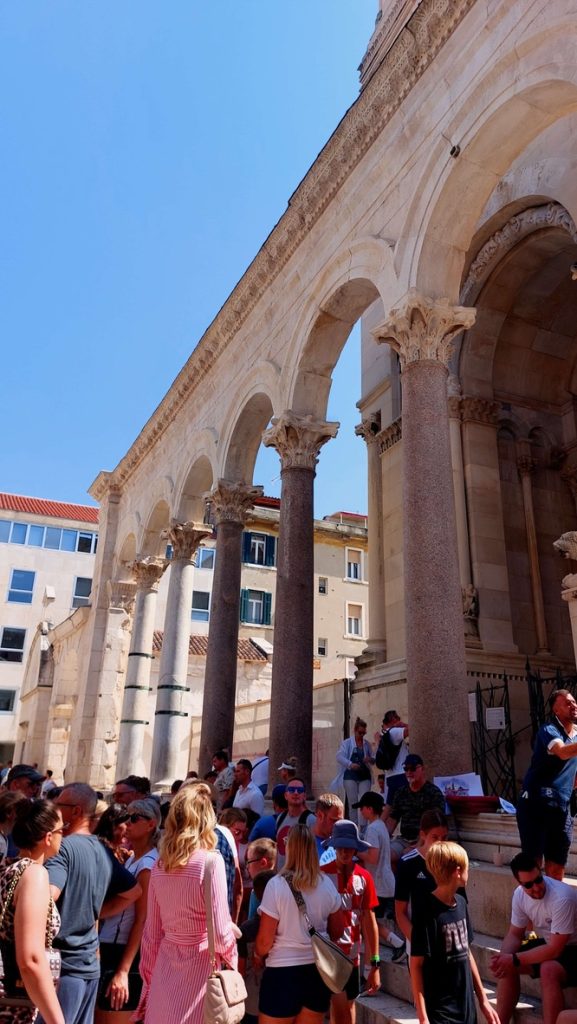
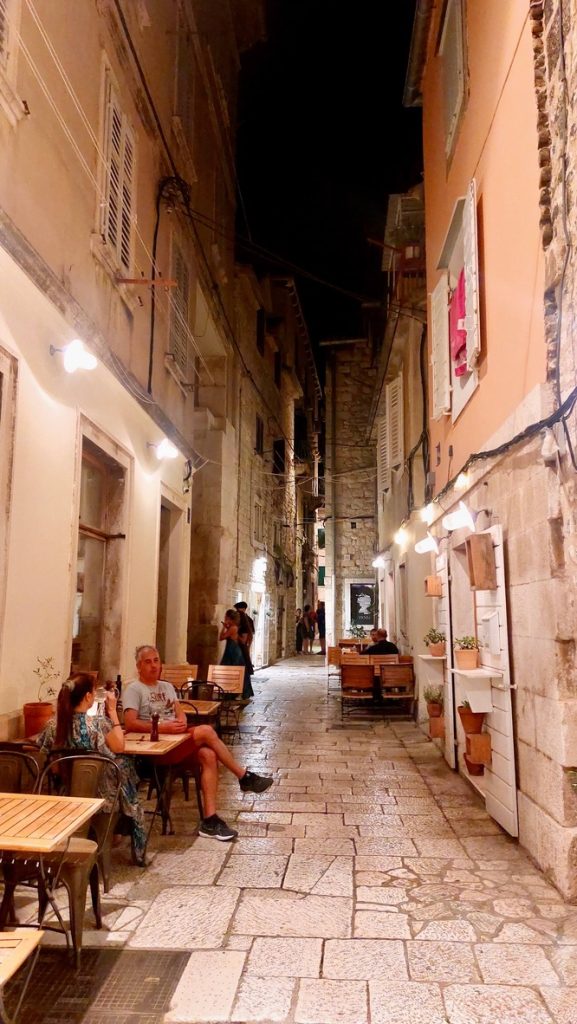
If you want to learn more about our next stop, go to: Visit to Šibenik, Croatia
Or else, our third & last stop, go to: Visit to Zadar, Croatia
For an overview of all travel posts of my blog, go to: My Home Page

